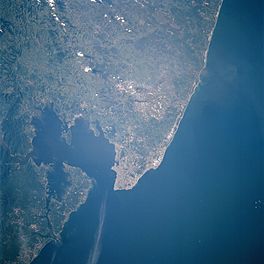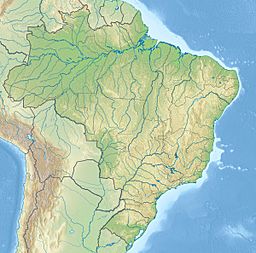Bay of All Saints facts for kids
Quick facts for kids Baía de Todos os SantosAll Saints' Bay |
|
|---|---|

Salvador and the Bay of All Saints in April 1997
|
|
| Location | Bahia, Brazil |
| Coordinates | 12°51′S 38°38′W / 12.850°S 38.633°W |
| River sources | Paraguaçu River Subaé River Jaguaripe River |
| Ocean/sea sources | Atlantic Ocean |
| Basin countries | Brazil |
| Surface area | 1,223 square kilometers (472 sq mi) |
| Average depth | 9.8 meters (32 ft) |
| Settlements | Salvador |
The Bay of All Saints (also called Baía de Todos os Santos in Portuguese) is a very important bay in Brazil. It is located on the eastern coast of Brazil, in the state of Bahia. The bay actually gave the state its name!
This large bay surrounds part of Salvador, which is the capital city of Bahia. It opens up to the Atlantic Ocean. The Bay of All Saints covers about 1,223 square kilometers (472 square miles). This makes it the biggest bay in all of Brazil.
At the entrance of the bay, you can see the Farol da Barra (Barra Lighthouse). This lighthouse stands on the site of an old fort. Most of the Bay of All Saints is not very deep. Its average depth is about 9.8 meters (32 feet).
The Paraguaçu River flows for about 500 kilometers (310 miles) before it empties into the bay. The bay also has 91 islands! The biggest island is Itaparica Island, which is located near the bay's entrance. Other important islands include the Ilha dos Frades, ilha de Maré, ilha de Bom Jesus, and the small Ilha do Medo.
Discovering the Bay of All Saints
The first European to visit this bay was an Italian explorer named Amerigo Vespucci. He arrived during his second trip to the Americas. This happened on November 1, 1501. This day is known as All Saints' Day.
Vespucci named the bay "Bay of the Holy Savior of All the Saints." He chose this name because of the date he arrived. He also thought of his church in Florence, Italy, called San Salvatore di Ognissanti.
At first, the bay, the main city, and the area around it all had the same name. But over time, they got different names. The state became simply Bahia. The bay became the Bay of All Saints. And the city became known as Salvador.
In 1501, just one year after Pedro Álvares Cabral's ships reached Porto Seguro, another explorer named Gaspar de Lemos arrived at the Bay of All Saints. He sailed along most of the Bahia coast. The first European to land on Morro de São Paulo was Martim Afonso de Sousa in 1531. He was leading a group exploring the coast of this new continent.
A Busy and Important Bay
By the early 1700s, Salvador was a very busy port. Many people were brought there to work, especially in the sugarcane fields of Brazil.
The bay was also a popular place during the time of whaling. This was because the bay was a special area where whales came to have their babies.
Today, the northeast shore of the Bay of All Saints is home to Brazil's first active oil fields. The city of São Francisco do Conde, located at the north of the bay, is still a port. It serves the oil refineries in Mataripe. The bay is regularly deepened by dredging. This helps keep it open for large ships to travel to and from the Atlantic Ocean.
See also
 In Spanish: Bahía de Todos los Santos para niños
In Spanish: Bahía de Todos los Santos para niños



